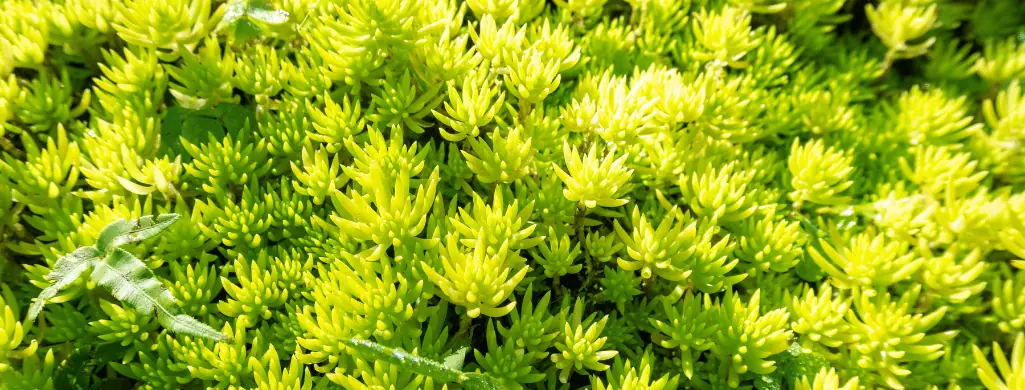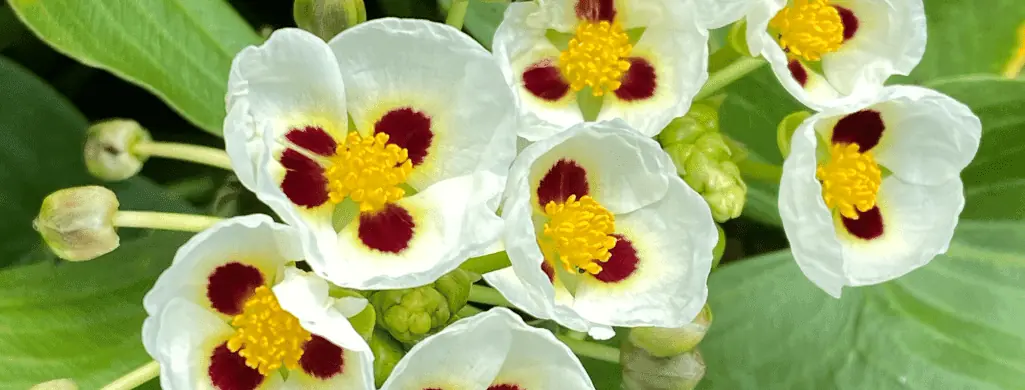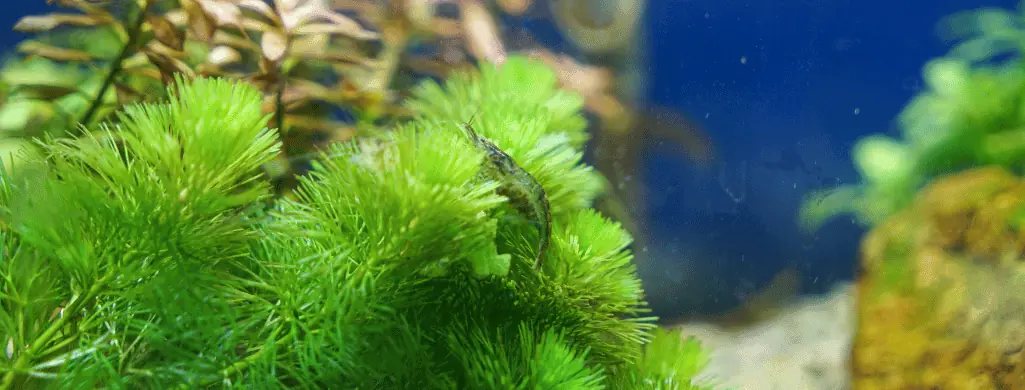Live plants create a more natural environment in an aquarium and provide several benefits.
A wide range of aquatic plants are available, and some stay small.
Small plants make excellent foreground features or ground cover in larger fish tanks. They also create lush aquascapes in nano tank setups.
We put together this list of the 16 smallest aquarium plants for all skill levels and aquarium sizes.
16 of the Smallest Aquarium Plants
1. Java Moss (Taxiphyllum barbieri)

Java moss is a common moss variety originating from Southeast Asia. It stays small and grows to a height of around three inches.
This freshwater aquarium plant is popular for its easy care needs and durability.
It grows best on porous surfaces like pieces of driftwood or rocks and has low to medium lighting needs.
When exposed to bright light, algae growth can overtake Java moss.
The slow growth rate of this moss means it only increases in size by 1″ inch per month. Added nutrients in the water can increase its growth rate.
Java moss prefers a warm water temperature range of 75-85° degrees Fahrenheit (29° C).
2. Dwarf Hairgrass (Eleocharis acicularis)

Dwarf hairgrass is a carpeting plant with a lush green color.
This grassy plant provides excellent cover for bottom-dwelling species like shrimp and snails.
Due to its rapid growth rate, dwarf hairgrass increases oxygen levels in the water.
Dwarf hairgrass prefers medium light levels and reaches a height of 1-2″ inches.
This plant is a popular choice for nano tank aquascapes and grows best in sand or loose aquarium soil. You can find our list of other aquarium plants that grow well in the sand here.
It is a suitable plant for beginners because of its easy care needs and hardy nature.
3. Anubias (Anubias barteri)

Anubias barteri comes in several varieties and is one of the most popular freshwater aquarium plants.
The smallest variety is the Anubias Nana Petite, which is 2-3″ inches tall.
This hardy plant can thrive in a wide range of aquarium environments, making it an excellent choice for beginners.
Anubias Nana Petites are rhizome plants and do not need a special substrate. Attach the plant to a piece of driftwood or rock with some cotton thread.
Covering the rhizome with a substrate can kill the plant.
Break the plant into 2.5″-inch pieces and plant each one at least an inch apart.
This plant prefers low to medium lighting and a temperature range of 72-82° degrees Fahrenheit (28° C).
4. Cryptocoryne (Cryptocoryne wendtii)

Most varieties of Cryptocoryne grow very tall. But the Cryptocoryne parva variety stays small with a height of 2.5″ inches.
Cryptocoryne parva, also called Dwarf Water Trumpet, has a slow growth rate and can take up to one year before it reaches its adult height.
Its slow growth makes it more prone to algae growth on the leaves.
This plant grows best in medium lighting in a wide range of temperatures from 59-82° degrees Fahrenheit (28° C).
Dwarf Water Trumpet needs an enriched substrate for the best growth. You may supplement your substrate with root tabs or use a liquid fertilizer.
When you first plant a Cryptocoryne parva it grows through a process known as melting. During this time, the plant sheds its leaves and appears dead.
Once the plant acclimates to its new environment, it regrows its leaves.
5. Water Wisteria (Hygrophila difformis)

Water wisteria does not stay small, and can grow up to 20″ inches tall. But trimming the plant keeps it small enough for use as a foreground plant.
This plant is popular because of its lacy leaves and bright green color.
Due to its rapid growth rate, this plant helps remove nitrates from the water. It also outcompetes algae growth.
Water wisteria goes through a melting phase, much like Cryptocoryne. It also melts when it does not receive enough lighting or nutrients.
This plant needs moderate to bright lighting and a 70-82° degrees Fahrenheit (28° C) water temperature range.
Create a carpet of water wisteria by planting it sideways in the substrate. Trimming vertical shoots keeps the plant low to the ground.
The plant propagates through cuttings and side shoots. Remove trimmings so the plant does not get overcrowded.
6. Java Fern (Microsorum pteropus)

Java fern is one of the most durable freshwater aquarium plants available.
This plant originates in Southeast Asia and grows on the waterline of mountain streams and rivers. It also grows as a wild grass in tropical rainforests.
As a rhizome plant, it grows best on objects like driftwood and rocks. Covering the rhizome with a substrate causes root rot.
Java fern thrives in low-light environments with temperatures of 59-82° degrees Fahrenheit (28° C).
Exposure to strong lighting causes melting and transparent spots on the leaves.
This plant provides shelter for bottom-dwellers like shrimp and corydoras.
7. Pygmy Chain Sword (Echinodorus tenellus)

Pygmy Chain Sword is an ideal aquarium plant for beginners. This carpeting plant is hardy and needs very little care.
This plant grows in marshes and streams in the Southern United States and parts of Central and South America.
It can form clusters of 10-15 stems and reach heights between 2-4″ inches.
The narrow leaves range in color from olive green to reddish-purple depending on the light intensity.
Pygmy chain sword has rapid growth and needs moderate to high-intensity lighting.
Control its spread by trimming overgrown roots and runners.
It needs an enriched substrate because it is a heavy root feeder. Supplement sand or gravel substrates with root tabs for extra nutrients.
8. Riccia Fluitans

Riccia Fluitans, also called crystalwort, is a suitable plant for all experience levels and tank sizes.
It is vivid green and forms tiny oxygen bubbles on the tips of its leaves in ideal conditions.
This plant is usually left floating but works well as a carpet on the substrate.
Crystalwort stays very small, with an average height of 1-2″ inches.
The plant has a rapid growth rate in moderate to bright light levels and prefers a temperature range between 68-79° degrees Fahrenheit (26° C).
Floating crystalwort needs lower light levels than crystalwort planted on the substrate.
It does well in slow currents, making it an excellent choice for a betta fish tank. Strong currents snap the fragile stems.
Trimming the plant prevents it from overtaking the entire tank.
Plant the crystalwort between two pieces of plastic mesh for a dense carpet. Over time, the crystalwort grows over the mesh and covers it completely.
9. Dwarf Baby Tears (Hemianthus callitrichoides)

Dwarf Baby Tears are tiny flowering plants used for creating a dense foreground cover.
This plant has bright green leaves and grows 1-2″ inches tall.
Its tiny oval leaves sometimes form oxygen bubbles resembling pearls.
Dwarf Baby Tears are slow growers and thrive in medium to high light levels.
A temperature range of 68-75° degrees Fahrenheit (24° C) encourages healthy growth.
The plant has a weak root structure and needs a loose aquarium soil or sand substrate.
Iron deficiencies cause yellow leaves in Dwarf Baby Tears. Supplement your plant with root tabs or liquid fertilizer.
Learn how to fertilize aquarium plants naturally in this article.
10. Flame Moss (Taxiphyllum sp. “Flame”)

Flame Moss is a vivid green plant with spiral leaves in the shape of flames.
When grown in an aquarium, Flame Moss only reaches a height of 3″ inches. This makes it perfect for nano aquascapes.
This plant grows in a wide range of temperatures from 54-86° degrees Fahrenheit (30° C).
It prefers low-light environments and suffers damage in brighter lights. Keep the plant away from direct sunlight or other forms of UV light.
Flame Moss grows best when anchored to objects in the aquarium. Adding nutrients is unnecessary because the plant absorbs what it needs from the water column.
Algae growth threatens Flame Moss, so you must maintain healthy water parameters.
Shrimp use the moss for shelter and feed on the biofilm layer covering the plant.
11. Marimo Moss Ball (Aegagropila linnaei)

Marimo moss balls get their shape from water currents.
This slow-growing plant only gains five millimeters in size over the course of one year. It has an adult size of 1.75-2.25″ inches in diameter.
The moss balls originate in Lake Akan, in Japan’s Hokkaido region.
Despite its name, Marimo moss is actually a rare type of algae.
This plant needs low-light environments and temperatures between 72-78° degrees Fahrenheit (26° C). Exposure to strong lighting turns the Marimo moss balls brown.
Marimo moss balls purify aquarium water by absorbing contaminants. Giving the plants a light squeeze when cleaning your aquarium removes some of the absorbed particles.
You do not need a special substrate for these plants. They float and sink in the tank on their own.
As a bonus, bettas and other playful fish enjoy having Marimo moss balls as toys.
12. Dwarf Sagittaria (Sagittaria subulata)

Dwarf Sagittaria is also known as Narrow-Leaved Arrowhead and is a grassy plant originating from South America.
It enjoys a wide range of temperatures from 59-84° degrees Fahrenheit (29° C) with low lighting levels.
This plant has a height of 4-6″ inches but can grow taller if left untrimmed.
Due to its rapid growth, it can overtake your aquarium. Frequent trimming prevents this and keeps the plant short.
Dwarf Sagittaria also grows in thick clusters. Removing runners with long leaves keeps the plant’s horizontal growth under control.
13. Hornwort (Ceratophyllum demersum)

Hornwort is a unique plant without true roots. Instead, the plant uses leaves and rhizoids for anchoring into the substrate.
This dark-green flowering plant has needle-like leaves measuring an inch in length.
If left untrimmed, the plant grows very tall. Weekly trimming helps hornwort maintain a compact size.
Hornwort thrives in both cold-water tanks and tropical environments. The ideal temperature range for this plant ranges from 59-86° degrees Fahrenheit (30° C).
High-intensity lighting and clear water encourages healthy growth.
This plant has a fast growth rate, but frequent pruning prevents it from overtaking your aquarium.
Hornwort sheds its leaves when conditions are less than optimal. Keep the plant away from the filter so it does not get clogged by the shed needles.
This plant is also featured on our list of flowering aquarium plants.
14. Taiwan Moss (Taxiphyllum sp. “Taiwan”)
Taiwan moss is a carpeting moss with easy care needs. This plant is an excellent choice for both beginner and experienced aquarists.
It is a less popular plant compared to Java moss. But, it has similar maintenance and lighting needs.
The moss grows two inches thick and thrives in temperatures ranging from 53-86° degrees Fahrenheit (30° C).
Taiwan moss helps keep the tank clean by reducing toxins and algae growth.
Like other mosses, this plant grows well on rocks and driftwood.
Acidic water and regular trimming encourage growth in Taiwan moss.
15. Monte Carlo (Micranthemum tweediei)
Monte Carlo is a carpeting plant with bright green leaves. It has a similar look to Dwarf Baby Tears.
This plant has a moderate growth rate with a height range of 1-2.25″ inches.
When the plant grows, it lifts the plant from the substrate. Anchor the plant with string or a heavy object for two weeks until it establishes roots.
Control the horizontal growth of Monte Carlo by trimming the plant.
Monte Carlo grows best in medium lighting with temperatures between 68-77° degrees Fahrenheit (25° C).
16. Water cabbage (Samolus valerandi/parviflorus)

Water cabbage grows in marshes all over the world.
Its leaves grow in a rosette shape and reach a diameter of around 4″ inches.
This plant is new to the aquarium hobby, so finding it is difficult.
Water cabbage is an excellent foreground plant in larger tanks as well as nano tanks.
It has a slow growth rate but needs very little maintenance.
The plant needs strong lighting for healthy growth.
Water cabbage can grow on the substrate or float on the surface. It is perfect for cold-water tanks and can withstand temperatures as low as 59° degrees Fahrenheit (15° C).
Small Aquatic Plants Can Make a Large Impact
You can create a lush environment no matter how much aquarium space you have.
Small aquarium plants make excellent foreground plants in large tanks. They are also ideal for a beautiful nano aquascape.
Color-changing plants like Pygmy Chain Sword add visual appeal to any aquarium.
Versatile plants like Marimo Moss Balls clean your tank water and even provide enrichment for your playful fish.


